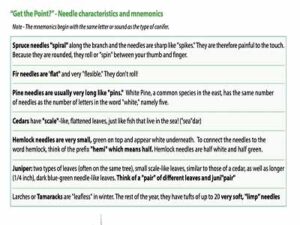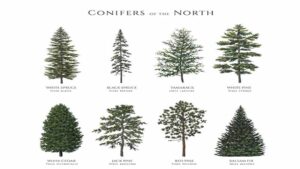What’s Needling You?
Ah the iconic Evergreen! To most of us, one Evergreen tree looks very much like another. But a more careful look and even a quick whiff, reveals how distinctive each can be. And knowing the differences between say a Spruce, a Hemlock and a Balsam Fir adds enormously to our enjoyment of nature. Although the needles are your main clue, many species also have a unique silhouette, which helps you to recognize them from a distance.
Below you will find a list of the needle characteristics of the main Evergreen families (biologists call these Conifers – because these trees bear cones) as well as some simple memory aids or “mnemonics” to help you recall them. To practice these mnemonics, try to identify the conifers in your yard while using the sayings from the chart below, while exploring your back yard, a nearby park or during a winter nature walk. You might also want to make a display of the different types of conifer needles (and cones) that you’ve found in your area.

Evergreens – The Shape You are In…
Here are some descriptions of the shape of typical conifers found in our area:
• White spruce: symmetrical, conical, wide, not pointed at top
• Balsam fir: narrow, symmetrical, tapered, pointed at the top. Resembles a church spire.
• Eastern white cedar: dense, cone-shaped, branches often go right to the ground
• White pine: often asymmetrical, branches at right angles to trunk, sometimes look like large wings

Get the Feel & Your Nose Knows…
Gather small sprigs of as many of the following as you can (Eastern White Cedar, White Pine, Red Pine, Scotch Pine, Western Cedar, Juniper, White Spruce, Balsam Fir, Hemlock) or any other conifer growing in your area. Always think about harvesting honorably, taking just a small amount from one place and then moving on to the next. Stuff each of the sprigs you gathered into a clean white sock far down into the toe so it can’t be seen. Ask you friends to stick their hands into each sock and just using their sense of touch, ask them to try to identify the needles. You’ll be surprised at the variety of needle shapes and sizes.
Notice how conifer trees have a different smell? Whether it is pine, cedar, spruce, fir, or hemlock, each species produces its own signature scent. Conifer trees produce terpenes, a chemical compound that protects them from insect and fungal infestation. There are two principal molecules in conifers: pinene, which has a piney odor, and limonene, which has more of a citrusy smell. Any combination of these two molecules, among some others, give conifer trees their distinctive scent. Using your socks stuffed with sprigs, can your friends identify each conifer by its smell alone?
Submitted by Jacob Rodenburg, Executive Director of Camp Kawartha, an award-winning outdoor education centre and summer camp.




